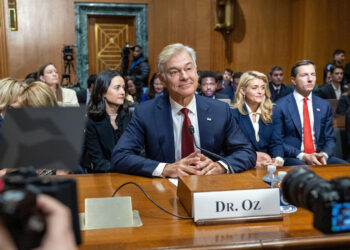Addition of the anti-TIGIT monoclonal antibody tiragolumab to standard first-line treatment resulted in better response rates and improved survival for patients with unresectable hepatocellular carcinoma, a randomized phase Ib-II MORPHEUS-Liver study showed.
At the clinical cutoff date, the 41 patients assigned to treatment with tiragolumab had a confirmed objective response rate of 43% compared with 11% among the 18 patients who received the standard regimen of atezolizumab (Tecentriq) and bevacizumab (Avastin) alone, reported Richard S. Finn, MD, of the University of California Los Angeles, and colleagues.
In addition, the median progression-free survival (PFS) was 12.3 months in the tiragolumab group compared with 4.2 months in the control group (HR 0.51, 95% CI 0.27-0.95), with higher PFS rates in the tiragolumab group at 6 months (75% vs 41%) and 12 months (50% vs 24%).
Median overall survival was 28.9 months in the tiragolumab group compared with 15.1 months in the control group (HR 0.39, 95% CI 0.19-0.78).
“To our knowledge, our study represents the first randomized, global study to report data for an anti-TIGIT monoclonal antibody in hepatocellular carcinoma,” Finn and colleagues wrote in Lancet Oncology, adding that the results of the study suggest that tiragolumab combined with atezolizumab and bevacizumab “could represent a promising novel first-line treatment option” in unresectable disease.
In a commentary accompanying the study, Thomas Yau, MBBS, of the University of Hong Kong, and colleagues noted that anti-CTLA-4-based dual immune checkpoint inhibitor regimens have “revolutionized the treatment paradigm by allowing a considerable portion of patients to achieve long-term disease control and survival.”
Thus, “we are eager to see whether the apparent increase in objective response rate in the tiragolumab plus atezolizumab plus bevacizumab group can ultimately translate into long-term survival benefits,” they added.
In explaining the rationale behind the study, Finn and colleagues said that while PD-L1 and VEGF blockade with atezolizumab plus bevacizumab was shown to improve survival in unresectable hepatocellular carcinoma in the phase III IMbrave150 trial, median overall survival remains at less than 2 years, “highlighting the continued unmet medical need for more effective first-line regimens to help improve patient outcomes in unresectable hepatocellular carcinoma.”
The MORPHEUS-Liver study was conducted at 26 centers across China, France, Israel, New Zealand, South Korea, and the U.S. from August 2020 to February 2022 and included 59 patients with previously untreated locally advanced unresectable hepatocellular carcinoma, an Eastern Cooperative Oncology Group performance status of 0-1, and a life expectancy of at least 3 months. Median age was 65 years, 79% were men, and most patients were either Asian (40%) or white (36%).
Certain notable adverse events were more common in the tiragolumab group compared with the control group, including pruritus (50% vs 17%), arthralgia (33% vs 11%), and diarrhea (30% vs 6%), although these were mainly grade 1-2.
The most common grade 3-4 adverse events were hypertension (15% in the tiragolumab group vs 11% in the control group), increased aspartate aminotransferase (8% vs 6%), and proteinuria (5% vs 11%).
Serious adverse events occurred in 53% of patients in the tiragolumab group and 56% of patients in the atezolizumab- bevacizumab group, and serious treatment-related adverse events occurred in 25% and 28%, respectively. Treatment-related deaths occurred in one patient in the tiragolumab group (due to cholestasis) and two patients in the control group (due to esophageal varices hemorrhage and upper gastrointestinal hemorrhage).
Yau and colleagues said that while the results of the study are “undoubtedly exciting,” they noted that it was small, with only 18 patients in the control group. This “probably contributed to the low observed objective response rate,” they suggested, pointing out that the response rate was lower than that seen with atezolizumab and bevacizumab in the IMbrave150 trial or the phase Ib GO30140 trial.
They also observed that the serious adverse event rates and serious treatment-related adverse event rates were “somewhat unexpected,” given the fact that this was an early-phase study, and that atezolizumab plus bevacizumab had an all-cause serious adverse event rate that was lower in the IMbrave150 trial, and a lower serious treatment-related adverse event rate in GO30140.
“Whether the three-drug combination would have unacceptably high toxicity in a larger population is an important question to be answered by the ongoing phase III IMbrave152/SKYSCRAPER-14 trial,” they suggested.
Disclosures
The study was funded by F. Hoffmann-La Roche and Genentech.
Finn reported receiving institutional grants from Adaptimmune, Bayer, Bristol Myers Squibb, Eisai, Eli Lilly, Genentech, and F. Hoffmann-La Roche; personal consulting fees from AstraZeneca, Bayer, Bristol Myers Squibb, CStone, Eisai, Exelixis, Eli Lilly, Genentech, Hengrui, Merck, Pfizer, and F. Hoffmann-La Roche; personal payment or honoraria for lectures, presentations, speakers bureaus, manuscript writing, or educational events from Genentech; and participation on a data safety monitoring board or advisory board for AstraZeneca and Hengrui.
Co-authors also reported multiple relationships with industry.
The editorialists had no disclosures.
Primary Source
Lancet Oncology
Source Reference: Finn RS, et al “Tiragolumab in combination with atezolizumab and bevacizumab in patients with unresectable, locally advanced or metastatic hepatocellular carcinoma (MORPHEUS-Liver): a randomised, open-label, phase 1b-2 study” Lancet Oncol 2025; DOI: 10.1016/S1470-2045(24)00679-X.
Secondary Source
Lancet Oncology
Source Reference: Wong JSL, et al “Insights into the future of first-line advanced hepatocellular carcinoma treatment” Lancet Oncol 2025; DOI: 10.1016/S1470-2045(24)00728-9.
Source link : https://www.medpagetoday.com/hematologyoncology/othercancers/113891
Author :
Publish date : 2025-01-22 21:19:28
Copyright for syndicated content belongs to the linked Source.


![author['full_name']](https://newshealth.biz/wp-content/uploads/2025/01/Anti-TIGIT-Shows-Promise-in-Unresectable-Liver-Cancer.jpg)












